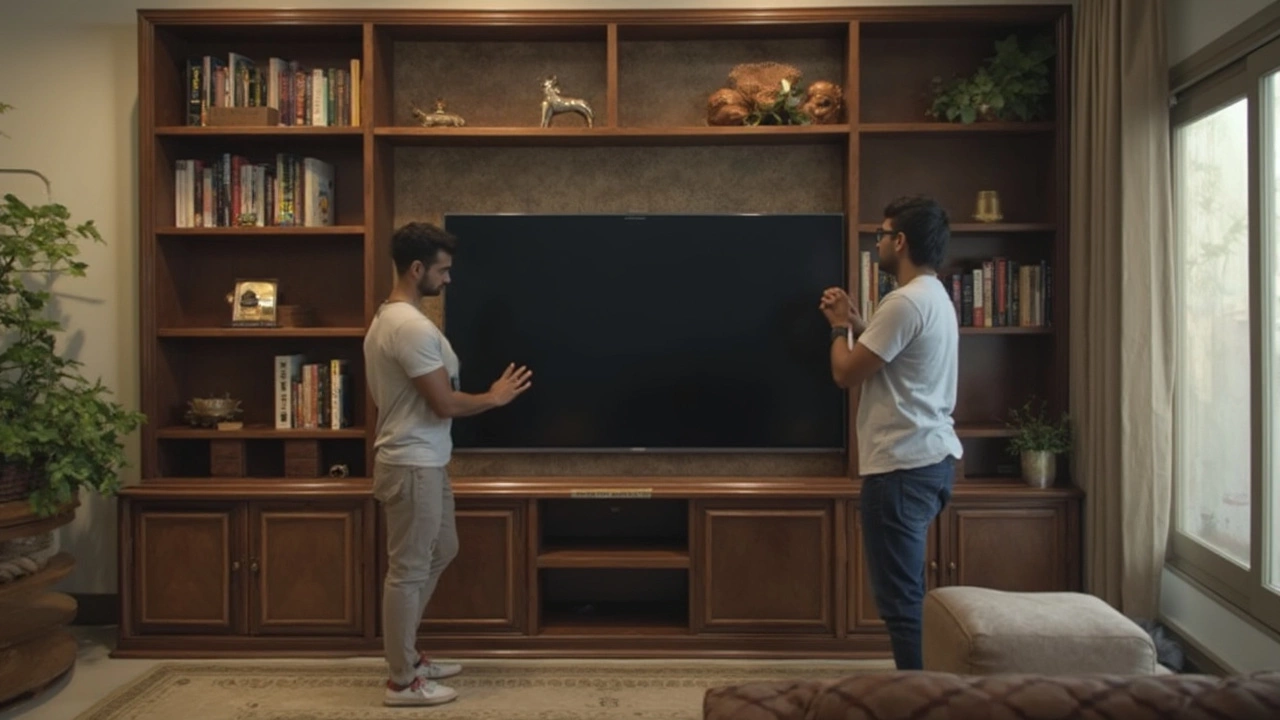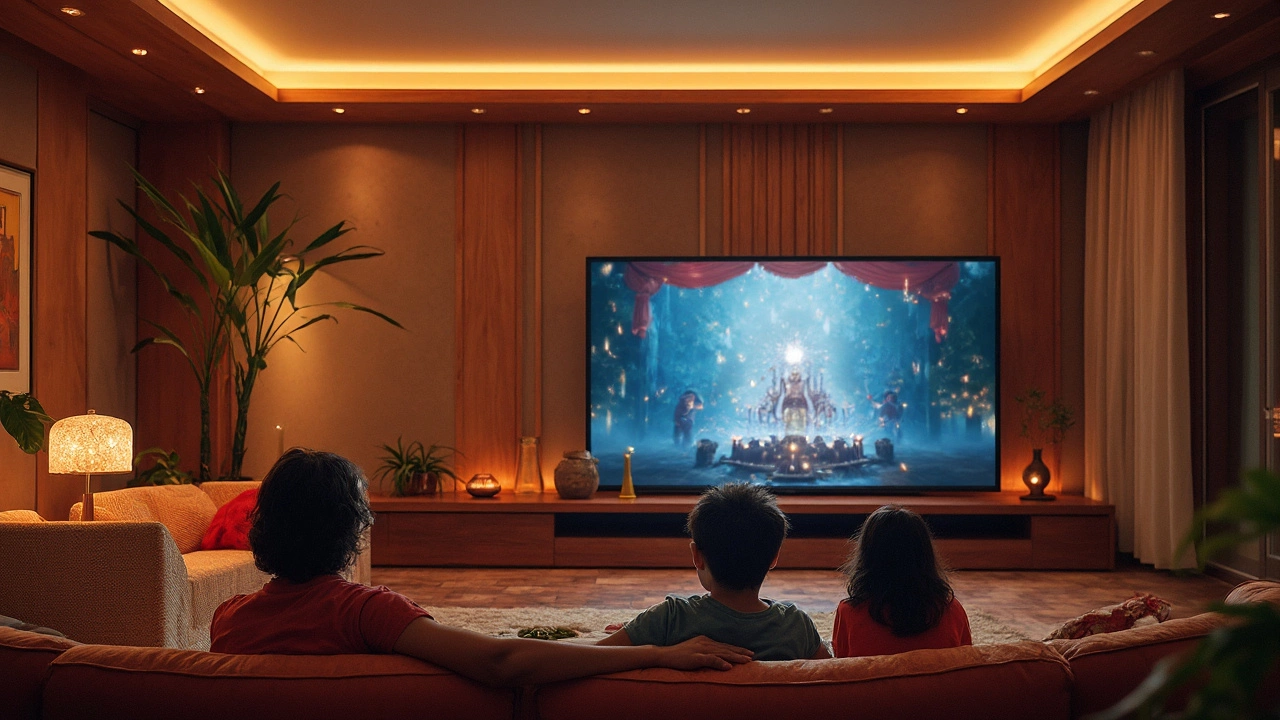Thinking about upgrading from a 65-inch TV to a 75-inch? You're not alone. The jump in size might seem modest at first, but those extra inches can make a world of difference in your viewing experience. But let's break it down to see what it really means.
First off, TV sizes are measured diagonally, from corner to corner. So, when you're comparing a 75-inch to a 65-inch, it's not just about those extra 10 inches diagonally. The actual height and width go up significantly, making the overall screen much bulkier. This means more visual impact and possibly a reshuffle of your living room layout.
For reference, a 65-inch TV is approximately 56.7 inches wide and 31.9 inches tall. A 75-inch TV, on the other hand, measures around 65.4 inches wide and 36.8 inches tall. That’s a noticeable bump, especially when figuring out where and how it fits.
So, why does it matter? With bigger screens, you get larger images, which translates to a more immersive viewing experience. If you enjoy movie nights or are a sports enthusiast, that added screen real estate can make every match or movie night unforgettable.
- Understanding TV Size Measurements
- The Physical Difference Between 65 and 75 Inch TVs
- Impact on Viewing Experience
- Room and Stand Compatibility
- Installation Considerations
- Final Tips for Choosing the Right TV
Understanding TV Size Measurements
So you're looking at different TV sizes, but how exactly are these magical numbers calculated? Well, let's demystify it. The size of a TV—like 65-inch or 75-inch—isn’t about its width or height. It’s all about the diagonal measurement. Imagine drawing a line from the lower-left corner to the upper-right corner of the screen, and there you have it: That’s your TV size.
Confused about how the diagonal translates to real dimensions on your stand or wall? Don’t worry. For example, a 65-inch TV typically spans about 56.7 inches in width and 31.9 inches in height. Jumping up to a 75-inch TV, the numbers bump up to about 65.4 inches wide and 36.8 inches tall. That’s a significant change you’ll want to accommodate, especially if your current TV stand or wall mount is just perfect for your old set.
On top of that, the frame or bezel of the TV sometimes adds a little to the overall size, though recent models are sleeker and more minimalistic. Remember, the screen size doesn’t account for those bezels. If you're buying a new TV stand, it's smart to measure your space first to ensure it’ll fit comfortably. This way, no big surprises when the delivery guy shows up.
For the true tech-savvy or those who just love details, here's a handy table to showcase the differences:
| TV Size | Width (inches) | Height (inches) | Area (square inches) |
|---|---|---|---|
| 65-inch | 56.7 | 31.9 | 1808.73 |
| 75-inch | 65.4 | 36.8 | 2405.52 |
See how the area makes a leap? It’s not just the width and height increase but the entire viewing space you're gaining. Understanding these measurements can help you make more informed decisions and optimize your living room for maximum comfort and enjoyment.
The Physical Difference Between 65 and 75 Inch TVs
When you're looking at moving from a 65-inch TV to a 75-inch TV, numbers on a page can only tell half the story. The big difference lies in just how much more screen you’re packing into your room.
Physically, a 65-inch TV measures around 56.7 inches wide and 31.9 inches tall. By contrast, a 75-inch TV stretches to approximately 65.4 inches wide and 36.8 inches tall. It might not look like a massive jump on paper, but this change translates to almost 33% more screen area. That's a hefty increase that you and anyone in your living room will definitely notice.
Want some more snackable data? Take a look at this comparison:
| Size | Width | Height | Screen Area (sq inches) |
|---|---|---|---|
| 65-inch TV | 56.7" | 31.9" | 1809 sq in |
| 75-inch TV | 65.4" | 36.8" | 2401 sq in |
That bump in size brings a richer, more immersive experience whether you're binge-watching or diving into the latest console game. But it's not just about the screen view; think about the frame too! It's usually a bit thicker or heavier, which might mean a sturdier TV stand or more secure wall mounting.
If your space allows for it, this wide viewing area makes movie nights seem almost theatrical. However, ensuring your room can handle the size is essential, so don't forget to measure wall space and viewing distance before making that leap.
Impact on Viewing Experience
So, you're thinking of moving up from a 65-inch to a 75-inch TV. It's not just about size; it’s about the whole vibe. Ever noticed how a larger screen can make everything look richer and more detailed? That's because your field of view becomes more immersive, almost like being in a mini movie theater at home.
But how does that work? Well, as the screen size increases, more pixels are spread out, ideally more densely packed in the same area, assuming you're upgrading to a higher resolution. This means more vibrant colors and sharper images. A 75-inch TV display can deliver that cinematic feel, allowing you to pick up on details you might have missed on a smaller screen. Imagine watching your favorite sports games and feeling as though you're right there in the stadium.
If you're into gaming, the larger screen size might just take it to the next level. It enhances the gameplay by filling a larger portion of your peripheral vision, letting you spot in-game details faster. It’s like stepping up from a normal canvas to an entire wall of visual wonder. The sounds and visuals can make you feel more connected and engaged.
Now, let's not forget about seating distance. The ideal viewing distance for a 75-inch TV should be around 7 to 10 feet. This ensures that you get the best image without noticing the pixels or straining your eyes. If you're too close or too far, the experience might not be as enjoyable.
To wrap it up, while both a 65-inch and a 75-inch TV will give you a good experience, those extra inches mean more than just numbers—they’re about creating an impactful and memorable viewing environment that pulls you into whatever you’re watching. It’s a great option for anyone looking to enhance their entertainment setup.

Room and Stand Compatibility
So you've settled on a big upgrade to a 75-inch TV from your trusty 65-incher. But it's not just the TV you need to think about — your room and TV stand play a crucial role too. Let's get into the nitty-gritty.
When it comes to room size, a larger TV demands more space, both physically and visually. Ideally, you'll want to sit about 7 to 10.5 feet away from a 75-inch TV for optimal viewing. That might mean rearranging your furniture to maintain comfort and avoid turning movie night into a neck-craning event.
Then there's the matter of the TV stand. A TV that's 75 inches is about 65.4 inches across. So, your stand needs at least that much space to hold it securely. You don't want it teetering on the edge, trust me. A sturdy, well-sized stand ensures both safety and aesthetics.
According to interior designer Emily Henderson, "A good rule of thumb is to choose a TV stand that's at least a couple of inches wider than your TV. Stability is key, but you also want it to be a seamless part of your room's design."
Here's how you can ensure your setup is spot on:
- Measure the width of your TV and add a little extra for both sides to determine the minimum width your stand should be.
- Ensure your stand can support the weight of your new TV. A 75-inch TV can weigh between 55 to 100 pounds, depending on the model.
- Consider the height of the stand. Ideally, the center of the screen should be at eye-level when you're seated.
Room aesthetics and viewing angles aside, safety is key. If you have kids or pets, think about wall-mounting your TV or investing in TV anchors. This prevents any accidents or tips.
Finally, think about the wiring. More size can mean more cables, so ensure your stand has space or slots for organized cable management. This keeps the look sleek and prevents tripping hazards.
Installation Considerations
So, you've decided to go big with a 75-inch TV. Awesome choice! But before you pop that bad boy on the wall, there are a few important things to keep in mind to ensure everything goes smoothly.
First, let's talk weight. A bigger TV means it's going to be heavier. Make sure the wall you're planning to mount it on can handle the load. Drywall might not be enough alone; you might need to find studs to anchor it securely. John Wheeler, a tech installation expert, put it this way:
"Always check your wall's weight capacity before mounting a large TV. Safety first!"
If you're going with a tv stand, ensure it's wide enough. A stand for a 75-inch TV should typically be at least as wide as the TV itself. You don’t want it tipping over just because the cat decides to jump up next to it!
Spacing is also key. Ideally, the distance from your viewing spot to the screen should be about 1.5 times the diagonal size of the screen. For a 75-incher, that's around 9 to 12 feet. Comfortable viewing ensures you don't miss a single pixel of that epic movie scene.
Don't forget about cable management. A neat setup doesn't just look nice, it also means fewer tripping hazards and easier connectivity between your TV and other gadgets.
- Check stud placement and use heavy-duty mounting brackets.
- Ensure your TV stand width matches or exceeds the TV width.
- Maintain optimal viewing distance—around 9-12 feet for a 75-inch screen.
- Use cable management solutions to keep everything tidy and safe.
With all this in mind, getting that 75-inch marvel up and running can be pretty straightforward. Just take your time and plan it out. Your Netflix marathons will thank you!
Final Tips for Choosing the Right TV
So, you're almost ready to bring home that bigger screen. Before sealing the deal, let's make sure that 75-inch TV will fit perfectly in your space and meet your needs. Here are some practical tips:
First, consider the TV stand. Bigger TVs need more support, so ensure your stand can hold the size and weight. Make sure it's sturdy and matches the dimensions of your 75-inch TV. You wouldn't want your centerpiece wobbling, right?
Next, think about viewing distance. Bigger doesn't always mean better if you're sitting too close. For a 75-inch TV, the ideal distance is generally about 8 to 10 feet away. That way, you can fully immerse in the action without straining your neck.
Don't forget about the room layout. Make sure the TV won't block pathways or clash with other furniture. Use painter's tape to mark out the TV size on your wall to visualize it before you buy.
- Room dimensions: Ensure the TV height and width will not overcrowd the room.
- Cable management: Sleek setups need planned cable routes to keep things tidy.
- Lighting: Minimize glare by positioning your TV perpendicular to light sources.
If you're still on the fence, check out customer reviews and expert opinions on the specific model you're eyeing. Real-world feedback can give you insights into the everyday experience of owning that gigantic screen.
Lastly, consider the future. A TV is a big investment, so think about its compatibility with tech gadgets and streaming platforms you might use down the line—whether it's a gaming console or the latest streaming box.

